Martin Edwards's Blog, page 42
May 25, 2023
Forgotten Book - A Crime of One's Own
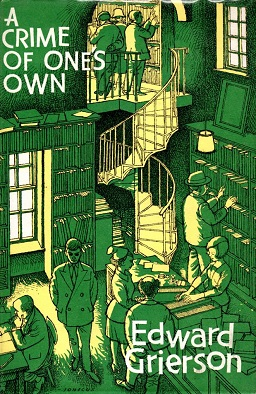
Edward Grierson's A Crime of One's Own has been sitting quietly in my TBR pile (mountain range would be nearer the mark) for quite a few years. I greatly admire his first crime novel, Reputation for a Song, and his award-winning second mystery, The Second Man, was also very good, but this one, published in 1967, is much less well-known. I'm not sure it even made it into paperback in this country.
Grierson was a barrister and a magistrate who wrote a varied mix of books. I get the impression of someone who, admirably, wrote to please himself rather than publishers, but despite his considerable talent this may have led to his work being neglected since his death in the mid-70s. This novel was his fourth foray into the mystery genre and he never returned to it.
Possibly he was disappointed by the book's lack of commercial success, but it's a story that I found very enjoyable. And it is a bibliomystery. The hero is Donald Maitland, the young and rather naive owner of a provincial bookshop and lending library. He begins to suspect that customers are using his books as a means of passing secret messages. Is there a link to a local high-security establishment? He soon has spies on the brain.
There are plenty of witty references to the world of authorship and publishing. I loved the satiric account of a publisher's letter breaking bad news to the hapless author Bernie Stredder, a splendid comic character with a darker side. The plot is rather wacky, but there's a good trial scene and plenty of swift but engaging characterisation. John Cooper, no mean judge, rates this book highly. And now I've finally read it, so do I.
May 24, 2023
Disappearance at Clifton Hill - 2019 film review
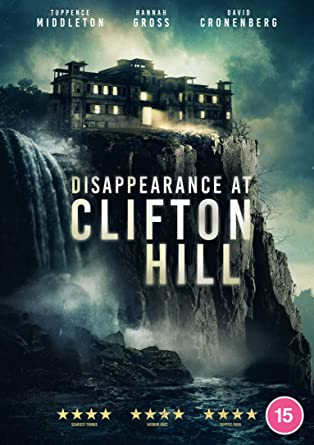
I have vivid memories of my one and only trip to Niagara Falls. It was on a coach trip from the Toronto Bouchercon a few years back and although the weather was a bit iffy, the company was splendid and the Falls were magnificent. Since then I've enjoyed watching the old film Niagara and now I've also taken a look at a recent movie set around the Falls - Disappearance at Clifton Hill.
The story begins with a family outing in rural Canada. A young girl is shocked to see a boy with a patch over one eye, who is clearly terrified. Then she witnesses his abduction. She tells the story, but nobody believes her. We then fast forward to the present. The girl is Abby, played by none other than Tuppence Middleton. Her sister is Laure (Hannah Gross). Their parents have died and a rather slimy lawyer has brokered a deal under which they sell their failing motel to a family called Lake, who own most of the little town.
Abby has gained a reputation, not least with her sister, for being a compulsive liar, so when she starts to reinvestigate the mysterious abduction, she gets little sympathy from anyone. A local conspiracy theorist called David Bell (David Cronenberg, perhaps better known as a director), seems more helpful. He is deeply suspicious of the Lakes and soon Abby discovers a connection between the boy she saw and a pair of stage magicians called the Magnificent Moulins.
The plot thickens nicely from then on. This is a well-made film and it boasts a final twist that came as a genuine surprise to me. Often these days, movie twists of that kind are rather meretricious but on the whole I think this one works well. This isn't as renowned a film as, say, Shutter Island, but I enjoyed it at least as much.
May 22, 2023
Glass Onion: A Knives Out Mystery - 2022 film review

I enjoyed Knives Out, a nice escapist whodunit. In commenting on my blog post about the film, the eminent critic Michael Dirda made some accurate criticisms of the plot, but like me he didn't let them spoil his pleasure too much. The success of the film meant that a sequel was inevitable and this takes the form of Glass Onion, in which Daniel Craig reprises his role as Benoit Blanc, the greatest detective in the world.
I feel that Glass Onion differs from Knives Out in two key respects. First, the set-up is even better. I was definitely gripped. Second, the film loses its way badly - in my opinion - in the latter stages. The mystery was easy to solve and the resolution excessively drawn out.
Miles Bron, a tech billionaire, invites five associates to a murder game party on his private Greek island. Their challenge is to solve his murder. Blanc also turns up, but Bron denies having invited him. Another guest is Cassandra, whom Bron removed from the business and subsequently defeated in litigation. It's clear from the outset that he cheated her and it also emerges that the other guests have motives to commit murder. However, when someone dies, surprise, surprise (or perhaps not!) - the victim isn't Miles. And then someone else is shot...
So far, so good. Edward Norton, as Bron, is convincingly odious. But we then get a very extended flashback which gives a very different perspective on the events as they have been presented to us so far. To a degree, this is quite clever, but it also tests credulity to the limits and beyond. Given that, at this point, most mystery fans will have figured out what is really going on (the central trick can be found in a couple of Agatha Christie novels), I began to lose interest. A pity, but perhaps writer and director Rian Johnson simply got carried away.
May 19, 2023
Forgotten Book - The Mendip Mystery
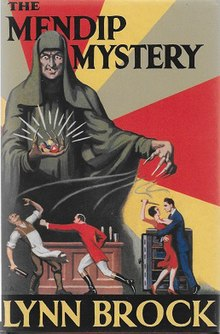
Lynn Brock (the main pen-name of the Irish novelist and playwright Allister McAllister) was a major figure in Golden Age detection and his character Colonel Wyckham Gore was, for a time, one of the leading fictional detectives in a crowded field. Brock's mysteries were convoluted and often ingenious, but although the quality of his writing was a cut above the average, his work soon faded from sight.
His strengths and his weaknesses are on display in The Mendip Mystery, published in 1929 and known as Murder at the Inn in the United States. Gore is asked by a chap called Stanton to look into the whereabouts of a woman who has been missing for many years. I found it rather astonishing that Gore didn't press for an explanation as to why his client wanted to track her down and this omission does rather haunt the story.
Anyway, off he goes to the south west, only to pick up another job. He stays at a very seedy inn, the sardonically named Bower of Bliss, and encounters two beautiful young women. Before long, all manner of dark deeds are taking place. At times it isn't easy to keep track of what's going on, and in due course some very lengthy explanations - a Brock trademark - are required, in order for us to understand fully all that has occurred.
There are some unorthodox ingredients, including a rare example of the murder of a child (rather horribly suffocated under a load of gravel - Brock was quite a tough writer) as well as some that are more commonplace and some (notably an account of escapees from an asylum) that definitely haven't stood the test of time. In particular, the ending is highly unusual.
It's not really a spoiler to say that the main culprit gets away with it, because Brock wrote a follow-up novel called Q.E.D., aka Murder on the Bridge, in which he revealed all. This was a daring experiment, followed up in rather lamentable fashion, a few years later by G.D.H. and Margaret Cole in another pair of novels, 'the Pendexter Saga'. Brock's endeavour is more successful, and I admire his ambition. He is one of those authors whose books are flawed but more interesting than many a smoothly accomplished formulaic whodunit.
May 18, 2023
Sepulchre Street - the first week's reviews
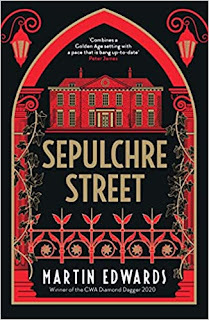
Many thanks to all the bloggers who took part in the blog tour organised by my publishers to celebrate the arrival of Sepulchre Street. When a reviewer takes the trouble to try to understand what an author is trying to do, and then expresses approval, it's hugely rewarding for an author. I'm also glad that the general view is that this story offers plenty of enjoyment even for readers who haven't read the previous books in the series. So I'm very happy. Here is a selection of comments:
‘A fascinatingbook…Martin has done something rather magnificent here. If this was written as a pure thriller, it would be a deeply satisfyingbook, but woven throughout the thrills is a cleverly plotted mystery – with a cluefinderat the end to prove it. It’s worth reading, but I do warn the reader thatthey’ll end up repeatedly kicking themselves at the things that they missed…Allin all, this is an absolute triumph…The best book so far in an outstandingseries.’
In Search of the Classic Mystery Novel
‘The opening of the book is one of the most inventive I haveread, perfectly setting up what is to follow…Martin Edwards poses manyquestions, with a wonderfully inventive plot, the writing combines all that isgood with the golden age but with a modern day twist. The plotting is superblythought out, constructed in a way that leaves a few clues along the way, thoughyou may not always pick them up, the book is paced perfectly for the period andjust flows along. There are touches of the gothic which only heightens thereading enjoyment. In parts there is a conspiracy taking place with somedefinite unsavoury characters who act first then ask questions later, overall aslick and taut plot knitted together by the quality of the writing.
Plotting though on its own is nothing if you don’t have thecharacters to match, this is another area where the book shines, it is hard notlike Rachel Savernake, strongly and fiercely independent she comes across as ano nonsense person not averse to taking a risk or two...Martin Edwards writescharacters that are relatable, you get a real sense of who each are and theperiod in which they live.
There is a certain humour within the book, equally its dripswith tension and drama, as it races towards the ending. Location plays itspart, the story moves seamlessly around, the way the book is written you can feelyourself there…a superb read, by a writer who knows how to engage with thereader, I was captivated throughout, the pace of the book perfect for thetimes. It takes the best of the golden age and combines it with a read fortoday…
Martin Edwards is a favourite author of mine, writing, plotting,character, location, setting his books have it all.’
Amwbooksreviews
‘A complex and deeply satisfyingmystery…Martin Edwards really can write. His plotting and narrative arebrilliantly done, and he weaves together marvellous threads which culminate insome wonderfully dramatic climaxes throughout the book…There are multiple plotelements but Edwards never loses his grip on these, and the final resolution isone I would never have guessed!
…The settings are vividly drawn and atmospheric, and I really felt I wasinside the action – the book is quite a page-turner…As well as plot andsetting, Edwards really excels when it comes to characters. His players arelively, entertaining and very well conjured; I was particularly impressed byhis ability to draw such strong female characters, and also to weave some ofthose issues women face into his plot without them ever sounding forced…Ithoroughly enjoyed this clever, absorbing and entertaining book…a wonderful read!’
Kaggsy’s Bookish Ramblings
‘Sepulchre Street is another fantastic,intriguing detective story from one of my favourite series…This book has agreat pace to it…The author drops lots of clues throughout the book so you haveto pay attention to everything…There is also a cluefinder at the back…I lovedthis idea and enjoyed going back to see the (many) clues I missed…this is afantastic series!’
Over the Rainbow blog
‘Sepulchre Street is the fourth in theRachel Savernake series and I think it is the best so far. It grips from thestart…I loved the nods to Golden Age crime fiction, the cluefinder, the map. A lotof the fun of the novel lies in the period details and the way in which the1930s are lovingly evoked: the clothes, the nightclubs, the songs (someinvented, but very much in the spirit of the time). Cocktails were all the rageand their appearance is something of a running joke…I romped though the novelfar too quickly and didn’t want it to end. All in all a splendid read.’
A Reading Life
‘Edwardshas written another corker of a thriller/detective story set in 1930’s London…apuzzle Poirot himself would be proud to have solved! You will need to payattention to every word to try to work out the ending…I thoroughly enjoyed itand would recommend it to fans of Agatha Christie who like a good puzzle tosolve.’
Two Heads are Better Than One blog
‘Mystery and intrigue aplenty fill the pages ofthis brilliant who-dunnit…I love the character of Rachel - clever, strong andsomeone who doesn’t suffer fools gladly…A wonderful nod to the Golden Age ofcrime and mystery writing, this is a series of recommend over and over.’
Wendy Reads Books blog
‘Iabsolutely love this series…Rachel Savernake is an excellent protagonist. Nononsense, clever, tough, and mysterious herself, she loves a challenge…Atwisting piece of thrilling golden age crime fiction to get your teeth into!’
Travels along My Bookshelf
‘Sepulchre Street is verywell-written and has a great storyline and has you hooked from the start…Anotherbrilliant book in the series and I can’t wait to see what Rachel is up tonext!’
Murder Jo Wrote
‘The author has created yet another immersive mystery that pulls you inand enthrals you with its surprising twists and turns! Enjoyably there is alsoa touch of the macabre and matched with a fast-paced, chic and sophisticatedsetting of the 1930s…Rachel is the perfect leading lady…witty, clever,intriguing and…thrilling.’
Secret World of a Book
‘Sepulchre Street is probably my favourite to date; fourbooks in the characters are developing nicely… There's a lot going on in here with all sorts oftwists and turns, some interesting hints for future directions the series mighttake, as many easter eggs as a dedicated classic crime fan could hope for, anda host of other fun references to chase up. It's no easy thing to build aconvincing past but I think Edwards does a really good job of it. It's hisobvious knowledge of and affection for Golden Age crime that makes it work forme, coupled with a cast of characters who are neither self-consciously old fashioned,or entirely modern but stuck in fancy dress. Add the gothic atmosphere (JohnDickson Carr would be proud) and character development to the other elementshere and it's a hard to beat series.’
Desperate Reader blog
‘Intriguing,clever, entertaining.’
What Cathy ReadNext
‘A thrilling and haunting read that is perfect for fans ofhistorical crime and detective fiction.’
A Cottage Full ofBooks
May 17, 2023
Eye in the Sky - 2015 film review

Eye in the Sky is an outstanding action film, much of its strength deriving from the way it balances high-stakes drama with an exploration of almost impossible ethical choices. The director, Gavin Hood, and the writer, Guy Hibbert, do sterling work and the acting is excellent. You'd expect that from the charismatic leads, Helen Mirren and Alan Rickman (whose last screen role this was) but a special word of praise must also go to Barkhad Abdi, who is brilliant as an undercover Kenyan agent, a testing role that he handles with aplomb.
The set-up is that Mirren is a tough British colonel who has been tracking a female terrorist for years. Intelligence has now been received that this woman and a group of other terrorists are gathering together. A joint operation between the Americans, British and Kenyans is to capture the targets. In London, Rickman is the deputy chief of the Defence Staff and he is in a COBRA meeting with top politicians. They all watch footage filmed via drones operated skilfully by Farah (Abdi) and this reveals that in fact the terrorists are plotting a suicide bombing mission. We see them strapping on the suicide belts. Capturing them is no longer a realistic option. If they are not killed by a remote-controlled missile, then a large number of people will die.
But there is a big problem. A small girl is selling bread just outside the compound where the terrorists are preparing. A missile strike may kill her too. Mirren is intent on eliminating the threat and Rickman, although less ruthlessly focused, concludes that is the right thing to do. But the politicians and lawyers waver. They are agonised by the choice and I can understand why.
The central difficulty in these terrible dilemmas, I think, is that we are human beings who look to humanise situations. We see the lovely and totally innocent girl, so any decent person will want to save her. But shouldn't a decent person also use their imagination to try to picture the significant number of other people who will suffer and die if no action is taken? It's easy to understand why decision-makers want to shuffle off final responsibility, but one of the most chilling - yet entirely believable - moments in the film comes when the politicians start thinking about the dilemma in terms of propaganda rather than humanity. I'm thankful that I've never been involved in any comparable life or death decision-making. But I have taken part in meetings to discuss high-stakes issues involving many people's livelihoods and futures and at such times, you see human nature in the raw. It's seldom a pretty sight, and this is made clear, compellingly, by Eye in the Sky.
This film also makes it clear that there are no easy answers, no consequence-free decisions. Balancing risks is crucial. But it's also very painful. A superb film, strongly recommended.
May 15, 2023
Celebrations and CrimeFest
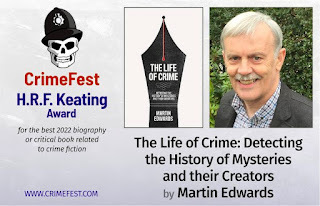
CrimeFest was a wonderful weekend of celebrations and catching up with old friends as well as meeting some very pleasant new people. For me, it was an occasion of great good fortune, so much so that even a long and tortuous journey home felt pleasant and relaxing! The highlight was undoubtedly the banquet on Saturday evening, when The Life of Crime was awarded the CrimeFest H.R.F. Keating prize for best non-fiction book about the genre, but there were many other great moments.
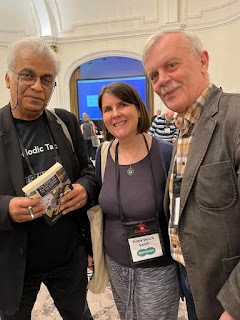
Not long after checking in and registering, I moderated an Authors Remembered panel, with an excellent group of colleagues covering an eclectic mix of authors: John Lawton (on Stanley Ellin), Peter Guttridge (Donald Hamilton), David Beckler (Friedrich Durrenmatt) and Chris Curran (VeraCaspary) - my own choice was Margot Bennett. After a pub meal with Simon Brett and other friends, some of us got together as a team for the annual pub quiz (not held in a pub, but in the hotel), and after a recount we managed to win, by a narrow margin. So prizes of books and DVDs - very nice.
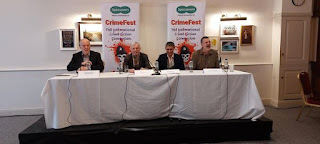
On Friday I took part in a panel moderated by the editor of The Life of Crime, the wonderfully cool David Brawn, along with Mark Billingham and Vaseem Khan; sadly, Covid meant that Janice Hallett couldn't join us, a real shame. In the evening, there was a very pleasant dinner hosted by the publishers Severn House, and talk about a possible book project. Before then, there had been a great moment when it was announced that The Life of Crime had been shortlisted for the Gold Dagger for non-fiction. The award has never been won by a book that isn't true crime, but it's great to see it in the list of finalists.

I was lucky to have three panels, concluding with one chaired by Maxim Jakubowski, and along with Mason Cross, Vaseem, Samantha Lee Howe, and Donna Moore we discussed our stories inspired by Cornell Woolrich for the Black is the Night anthology. On a sunny afternoon I enjoyed walking along the river with Jason Monaghan and Dea Parkin before the drinks reception which preceded the banquet and the great moment when I was presented with the award. After that I was quite happy to go along with others to watch the conclusion of Eurovision!
It was wonderful to see people again and also to catch up on some lovely reviews of Sepulchre Street on the blog tour. All the copies on sale in the book room were snapped up, which is always gratifying. As ever, huge thanks go to Donna and Adrian Muller for all their hard work in making CrimeFest such a great event. It was very memorable for me and I'm truly appreciative.
May 12, 2023
Forgotten Book - Deadly Pattern
I enjoyed Douglas Clark's The Libertines sufficiently to seek out another in his long series of police procedurals featuring Masters and Green, which encompassed no fewer than 27 books appearing between 1969 and 1990. The premise of Deadly Pattern, which dates from 1970, intrigued me, as did the setting - a rather bleak bit of the seaside on the Lincolnshire coast. It's a short book, with interesting elements but regrettable flaws.
Five women in their forties have gone missing from the area and recently the bodies of four of them have been found, buried in rather shallow graves in the sand dunes. The local police are baffled, so Masters and Green are called in to solve the mystery. And finding this particular serial killer involves not only finding the fifth body but also figuring out a motive - what is the pattern that connects the victims?
I imagine that, when this book came out more than half a century ago, serial killer novels were quite a novelty. When we read the story today, having probably read lots of books of this kind, we hope for some degree of originality in treatment. The setting appealed to me - I'm not sure where it's modelled on, but Cleethorpes may be a possibility - as did some elements of the plot. However, in some respects I found the story lacking.
Why? Clark's style is pleasingly readable, but it has irritating features - for instance, anybody who can't tolerate casual sexism should probably give it a miss, because by any standards the relentless chauvinism does become wearisome. Green, the sidekick, is a bolshie radical of sorts, and I'm not clear from the books I've read what Clark was trying to do with the character, I can see there's a contrast between him and Masters, but it's too crudely done for my taste. Above all, the book disappointed me because - even though the connecting link in the pattern seems relatively feeble to a modern reader - there are good ingredients in the storyline, but I think Clark could have made much more of them. This was either a short story idea or one that could have been developed with more attention to characterisation and mystification - as it is, the serial killer is screamingly obvious. I did entertain some hope that I might have been cunningly misled about his identity - but no such luck. However, as Jamie Sturgeon helpfully pointed out when commenting about The Libertines, Clark got into his stride with his later books.
May 10, 2023
Sepulchre Street, Crimes of Cymru, and more...
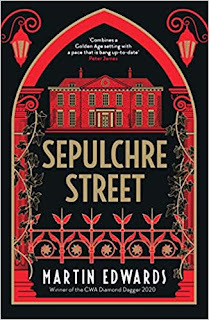
I'm having quite a week. A workshop for writers in Frodsham on Sunday, followed by an Anthony award nomination for The Life of Crime on Monday and an enjoyable event at Newark Library yesterday talking about My Life of Crime. Today sees publication of my latest British Library anthology, Crimes of Cymru, and tomorrow, as I set off for CrimeFest, Head of Zeus aka Aries Fiction are publishing the fourth novel about Rachel Savernake, Sepulchre Street.
It's a busy time, but I'm acutely conscious that the nice things that are happening right now are the culmination, in many ways, of years of work on my writing. So I'm determined to make the most of the good times. And I am truly gratified by the very first review of Sepulchre Street, for the blog tour, which comes courtesy of Puzzle Doctor on his great blog In Search of the Classic Mystery Novel; 'an absolute triumph...The best book by far in an outstanding series.'
It's immensely rewarding when a thoughtful reviewer 'gets' what you are trying to do, and Puzzle Doctor picks up on a key element of this and the other Rachel novels, namely that I'm trying to introduce material into the stories that Golden Age writers wouldn't have written about, but doing so in a way that is (I like to think) consistent with the approach that the better authors would have adopted, had social taboos been different. And by this, I don't mean graphic sex and violence, by the way - there is some violence, but not more so than in plenty of Golden Age books, although I try to treat it quite seriously, because I find violence frightening.
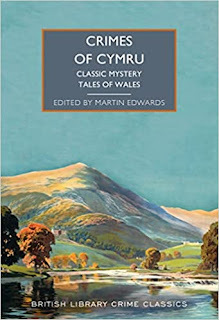
Crimes of Cymru is an anthology that was especially interesting to compile. At first, the prospect of finding enough good classic Welsh or Wales-related crime stories to fill a book seemed quite a challenge but thanks to help from a number of experts in the field, I've come up with a collection that I think is eclectic and strong. It's been a particular pleasure to collaborate with Janet and Rebecca, the daughters of the Welsh author Cledwyn Hughes, one of whose stories features in the book, and I am hoping that this publication will kick-start a revival of interest in his work.
May 8, 2023
The Man with the Golden.....Derringer!
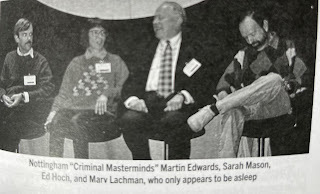
I had an extremely surreal moment at Dublin Airport last week as I waited for a connecting flight to Manchester after travelling back from the States. I glanced at my emails and found one sending congratulations, not for the Edgar win, but for something completely different. I was told I'd won a Lifetime Achievement award from the Short Mystery Fiction Society. Or, to give its full name, the Edward D. Hoch Memorial Golden Derringer for Lifetime Achievement. I must admit that for a time, I thought I was imagining this, while carried away on a wave of excitement after the Edgars. But I wasn't hallucinating and now I've had time to take it all in properly, I must say that this award is a source of great pride and delight for several reasons.
First, I look at the previous winners of the Golden Derringer, going back to 1999. The only previous British winner is the great Ruth Rendell (all the other winners have been Americans, including such notable names as Lawrence Block, Loren D. Estleman, Ed Gorman, Bill Pronzini, and S.J. Rozan). It's wonderful to be in such company.
Second, I knew Ed Hoch and he was a delightful man. He and his wife Pat showed me a number of kindnesses on our occasional encounters at Bouchercons. He was also a brilliant and incredibly prolific short story writer who wrote a wonderful story, inspired by Alice in Wonderland, for my anthology Green for Danger. We took part in the 1995 Bouchercon Mastermind quiz together - a photo of that memorable occasion is to be found in Marv Lachman's book The Heirs of Anthony Boucher - see above. It's a real privilege to win this award named in his honour. And I like to think Ed would be pleased.
Third, I really love short stories and reading the short stories of others, as well as writing my own, is a source of continuing pleasure. I've used the form to experiment and to try to develop as a writer and this has worked really well. They have brought me a few prizes and nominations, starting with my very first story, 'Are You Sitting Comfortably?', which was the first fiction I had any success with. To be recognised now by my peers in this way really is amazing.
Fourth, it occurred to me, once I'd got over my jetlag, that I've now won lifetime achievement awards for fiction (CWA Diamond Dagger and the Dagger in the Library), non-fiction (the Poirot award), scholarship in the mystery field (the George N. Dove award) and short fiction (the Golden Derringer). I must admit I find it hard to believe that I've been so lucky. It's something I never expected, even in my wildest dreams as a would-be crime writer, but it really is extremely gratifying . And truly humbling.



